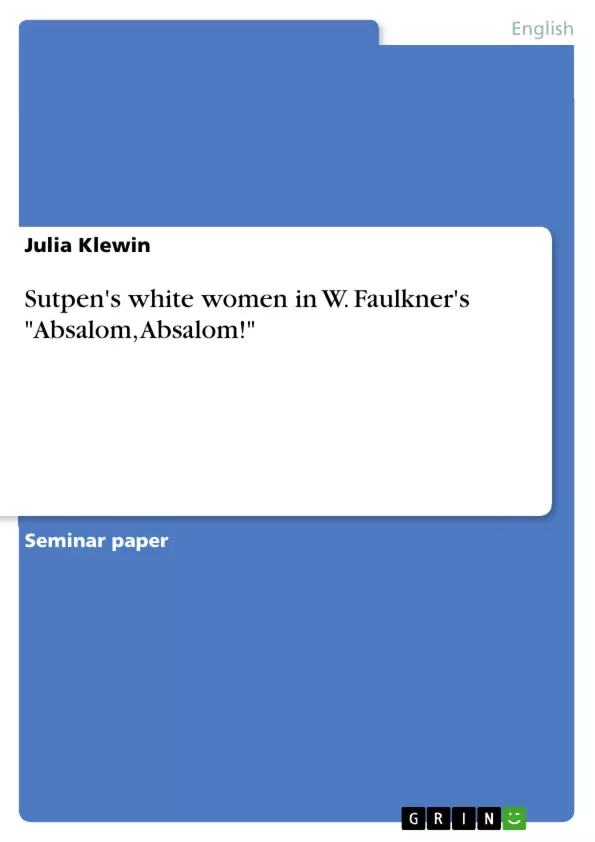William Faulkner’s novel Absalom, Absalom! is often proclaimed to be one of his
best writings no matter how hard and difficult the first glance seems to be. After I had finished Faulkner’s “masterwork” (Dimino 181), I decided at once
to choose it for my term paper.
For me, the novel is not a difficult one: It is demanding and gives you, as a reader, the opportunity to activate all of your background information and ideas concerning a story about the South. Of course, it is not a kind of book you can ‘look through’ at one day on your vacation, but it is hugely eventful that you could read it again and again without loosing interest. The more often you spend some time with Absalom, Absalom!, the more you will find out about the plot’s hints and ideas.
This term paper concentrates on Thomas Sutpen’s three white women, namely Rosa Coldfield, Ellen Coldfield Sutpen and Judith Sutpen. To be examined are their roles in the novel, their relationship to Sutpen and their femininity or gender respectively. The interpretation of Rosa will be the largest one, because she gives the reader as a narrator more information than the other females.
After a short overview of Absalom, Absalom!, I begin every analysis of the single white female characters with a short introduction of their biography and status, before I describe more detailed aspects and facets of their functions in the story.
Because the novel itself is full of useful passages that have to be interpreted and questioned, I have decided to limit the secondary literature for this term paper in order to stay close to the book as much as possible. My research in the internet did not turn out to be useful for this term paper.
What perhaps might be true in Absalom, Absalom!
One absolute important aspect which should be kept in mind during entire the
novel is the fact that nothing actually is a fact. When you think you are done with
Faulkner’s Absalom, Absalom!, you suddenly realize that every detail of the plot
has to be questioned and rethought.
In Absalom, Absalom!, the reader comes across three or rather four
narrators:
Starting with Rosa Coldfield, Faulkner introduces furthermore Mr. Compson who
passes over his father’s stories about his friend Thomas Sutpen in
Yoknapatawpha County and the roommates at the Harvard dormitory, Quentin
Compson and Shrevlin McCannon.
As it would not be enough, two totally different
settings move the detailed hints about the plot even more apart from each other.
Table of Contents
- Introduction
- What perhaps might be true in Absalom, Absalom!
- Sutpen's White Women
- Rosa Coldfield
- Question of Objectivity
- Alienation
- 'Un-Feminine'
- Ellen Coldfield
- Ellen as Sutpen's Status Symbol
- Judith Sutpen
- Strong Fiancée without Engagement
- Rosa Coldfield
- Conclusion
- Bibliography
Objectives and Key Themes
This term paper aims to analyze the roles of three white women in William Faulkner's Absalom, Absalom!, namely Rosa Coldfield, Ellen Coldfield Sutpen, and Judith Sutpen. The paper will examine their relationships with Thomas Sutpen and explore their femininity and gender roles in the context of the novel.
- The subjectivity of the narrators in shaping the narrative
- The ambiguity and unreliability of the events depicted in the novel
- The complex and multifaceted portrayal of the female characters
- The influence of societal expectations and gender roles on the women's lives
- The impact of Thomas Sutpen's ambition and actions on the women
Chapter Summaries
The first chapter provides an introduction to the novel and its themes. It highlights the importance of questioning the events and perspectives presented, emphasizing that nothing in Absalom, Absalom! can be taken at face value. The chapter also introduces the novel's multiple narrators and their individual biases, highlighting the complexity of interpreting the narrative.
The second chapter delves deeper into the concept of truth and unreliability in the novel. It discusses the challenges in reconstructing the past events through the fragmented and subjective accounts of different narrators. The chapter also touches upon the multiple timelines and the impact of historical context on the story.
The third chapter focuses on the three female characters, namely Rosa Coldfield, Ellen Coldfield Sutpen, and Judith Sutpen. It examines their roles within the novel, their relationships with Thomas Sutpen, and how their lives were affected by his actions. The chapter also explores their identities and their struggles within the prevailing societal expectations and gender roles.
Keywords
Key terms and concepts in this paper include: Absalom, Absalom!, William Faulkner, Thomas Sutpen, Rosa Coldfield, Ellen Coldfield Sutpen, Judith Sutpen, Southern Gothic, narrative subjectivity, unreliable narrators, gender roles, societal expectations, ambition, tragedy.
- Quote paper
- Julia Klewin (Author), 2007, Sutpen's white women in W. Faulkner's "Absalom, Absalom!", Munich, GRIN Verlag, https://www.grin.com/document/86110



